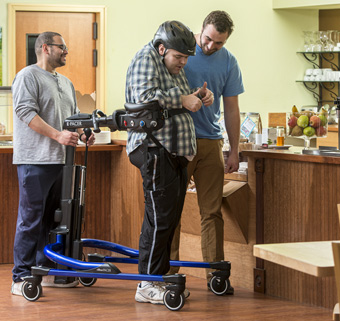 Locomotor deficits, presenting in balance issues and decreased speed and distance, are one of the primary reasons patients with injuries to the central nervous system receive rehab intervention. And with good reason: for a patient whose goal is to return home, walking ability strongly predicts function, participation and quality of life.1-4 The best strategy for helping a patient return to functional walking has been widely researched but not synthesized. Until now, that is. The Journal of Neurologic Physical Therapy recently published “Clinical Practice Guideline to Improve Locomotor Function Following Chronic Stroke, Incomplete Spinal Cord Injury, and Brain Injury,” and it’s a welcome addition to the field of neurorehabilitation. Significantly, the synthesis shows that the unifying theme of the clinical practice guideline (CPG) extends to the motor learning principles of amount, specificity and intensity, recognizing their importance in influencing the efficacy of any locomotor intervention. It’s a message that I believe needs more recognition.
Locomotor deficits, presenting in balance issues and decreased speed and distance, are one of the primary reasons patients with injuries to the central nervous system receive rehab intervention. And with good reason: for a patient whose goal is to return home, walking ability strongly predicts function, participation and quality of life.1-4 The best strategy for helping a patient return to functional walking has been widely researched but not synthesized. Until now, that is. The Journal of Neurologic Physical Therapy recently published “Clinical Practice Guideline to Improve Locomotor Function Following Chronic Stroke, Incomplete Spinal Cord Injury, and Brain Injury,” and it’s a welcome addition to the field of neurorehabilitation. Significantly, the synthesis shows that the unifying theme of the clinical practice guideline (CPG) extends to the motor learning principles of amount, specificity and intensity, recognizing their importance in influencing the efficacy of any locomotor intervention. It’s a message that I believe needs more recognition.
Clinical Recommendations for Gait Training in Neurorehab
It’s important to note that this CPG only includes studies with participants who were greater than six months post stroke, iSCI and TBI and with a primary outcome of walking speed or distance. Therefore, these recommendations do not directly apply to individuals in the early rehabilitation phases or to those who are non-ambulatory. Even so, the findings are compelling:
- Strong evidence suggests using moderate– to high–intensity (70–85% HRM) walking training interventions improves walking speed and distance as compared to less task–specific and more passive interventions.
- Strong evidence suggests using virtual reality training coupled with walking practice for the carryover of locomotor tasks to a variety of contexts not otherwise available in the hospital or clinic results in improved walking distance and speed as well as generalization of the task.
- Available evidence indicates that strength training, cycling and circuit training are inconsistent in improving walking distance or speed in individuals with central nervous system injury. However, they still “may be considered” in intervention strategies especially at higher intensities.
- Strong evidence suggests that static and dynamic balance activities to improve postural stability and weight–bearing do not contribute to improvements in locomotor function.
- Evidence suggests that body–weight–supported treadmill training or robotic treadmill training does not improve locomotor function. However, this recommendation should be interpreted appropriately because, as noted above, all participants included in the CPG were greater than six months post CNS injury and already able to walk.
Overall, the recommendations make a robust case for the benefits of intense and task–specific intervention to improve gait rehabilitation outcomes. In other words, challenging and frequent over–ground walking opportunities have the best clinical carryover to functional ambulation for individuals further along in the rehab phase.6,7
Using Equipment to Further Ambulation Outcomes
Although not directly referenced in the clinical guideline, adaptive walkers and gait trainers are often required to support the intensive walking effort by reducing patient fall risk and patient fatigue.8,9 The Pacer gait trainer, E–Pacer and Rifton TRAM have been a part of the recovery process at multiple rehab facilities for just this reason. These devices provide body–weight–supported overground gait training opportunities allowing the patient to train safely and repetitively in task–specific environments, progressing eventually to independent ambulation.
Josh Carpenter used the E–Pacer, a supportive gait trainer with transfer assistance, at Spectrum Rehab to regain walking ability after a spinal cord injury.
In the case of Sean Carter, a Pacer gait trainer supported him in repetitive over–ground walking opportunities to achieve independent walking five years after a traumatic brain injury.
Janette Tazzia and her therapist Linda Rusieki, DPT explain how the Rifton TRAM, a compact gait training and transfer device was instrumental in her recovery after a stroke.
Back to Top** This post was originally published on http://www.rifton.com/adaptive-mobility-blog/blog-posts/2020/february/guideline-to-improve-locomotor-function-in-neurorehab

